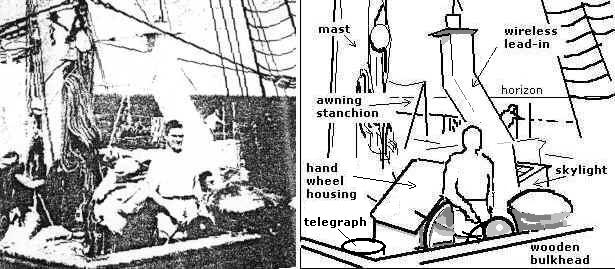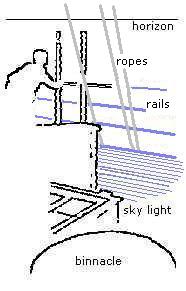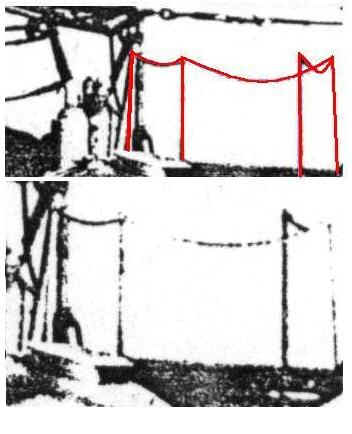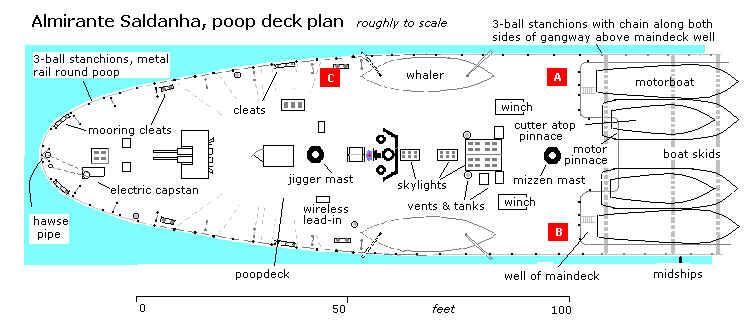
The Trindade Island Photographs 16 Jan 1958
A
study of the camera position
(Mar
2004. Last update 16 Mar 2004)
(index) Part Two (<Back to Part 1)
In Part One we discussed information locating the photographer in the stern of the Almirante Saldanha and identified some conditions that need to be met in order to narrow down the position accurately. Here we try to correlate available photographs and plans of the ship by means of some crude photogrammetry to discover where Barauna may have been standing.
We begin with the photo shown below, a view looking aft and to port from the centre of the poop deck just forward of the jigger mast :

Fig.6. Jose Viegas, pictured at the power steering wheel in a view looking port aft. From O Cruzeiro March 08 1958. Some key features identified on sketch at right.


Fig.7. Detail from the picture above, showing line of sight across compass binnacle to a pair of vertical stanchions beside the figure at the deck rail in the background. (The rail reconstructed on the right corresponds to a ~45" height subtending ~4.5° at 48' from the camera. See below)
The vertical stanchions shown in Fig.7 differ from the much taller inverted "V" of the standard awning stanchions, one of which is visible in the left background of Fig.6 and in close-up in Fig.8. These "V" frames are normally set all around the fo'castle and poop decks at average 10'-12' intervals, and one would normally be in this position (as can be seen at larger scale on the plan in Fig.9 below). But they are removable and are designed to come apart at the top joint where they clip over the awning cable.
| Barauna at the rail next to the
sternmost port mooring cleat (at the extreme left end of
Fig.3). The adjacent "V"-shaped awning
stanchion appears to be off-vertical and partially
unhooked, hanging on its cable. Fig.8 |
|
The awning is obviously not in use and the "V" frame at this position appears to have been disassembled, evidently to accommodate these two shorter vertical stanchions as part of some unrelated structure. (Evidence of partial disassembly of another port awning stanchion further aft is visible in Fig.8.) These changes may be in connection with adaptations made in 1957 for IGY oceanographic survey work.
In February that year some sailors' quarters were transformed into a laboratory and the platform of the 23-foot torpedo tube - a 7½-foot rotating mounting on the maindeck under the port-side boat skids - was replaced with a seabed sampling probe served by over 16,000 feet of cable. We can also see from the photographs that the "wireless lead-in" has been moved across from the starboard to the port side of the jigger mast for some reason. (This is the oblique white structure visible behind the figures in Figs. 6 & 10; presumably it is a shielded duct for the radio aerial cable running to the masthead.)
|
Fig.9 Sightlines establishing approximate position of camera for photo of Viegas (Fig.6)
Some other features visible in the photo of Capt.Viegas in Fig.6 can be matched against the deck plan and thus allow us to establish some angles and distances by triangulation of sightlines. These sightlines are:
over the near corner of the teak bulkhead and the 'roof' of the handwheel housing to the awning stanchion
over the near corner of the teak bulkhead and the telegraph to the jigger mast
over the compass binnacle and the port-forward corner of the skylight.
These sightlines determine a location approximately as shown in Fig.9, some 16' from Viegas.
From this position it is possible to calculate approximately the printed angular field of view of the photograph, which appears to be a square format a little less than 40° wide.
One reasonably dependable known quantity is the visible height of Viegas himself, which we can be confident should give us a result accurate to within about 10% allowing for the variability of human stature: For example, if 3' 6" of Viegas is visible from above the knee then at 16' range he subtends about 12.5° and therefore the printed FOV is about 36°.
Another rough cross-check is the distance between the two shroud lines visible at the far right of Fig.6. If the camera location is correct then the shrouds are about 43' from the lens. The rigging plan shows these lines about 60" apart at the awning level, which gives a subtense of about 6.6° corresponding to an FOV of about 40°.
Finally the ~ 19° angle between the sightlines in Fig.9 covers about one half of the linear width of the photograph, leading to an FOV of about 38°, which is the mean of the above figures and is consistent with the FOV of Barauna's 6x6 'square' format Rolleiflex 2.8E, assuming that the negative area is not greatly cropped.
Having established a rough angular yardstick we can infer some other things. For example, we can also say that the photographer was standing on something. The camera is considerably above Viegas' eye-height, because with the lens at this height the line of the sea horizon would, assuming a level deck, be level with Viegas' eyes). The depression angle from the horizon to Viegas' eyeline can be measured off from the print as 6.3°, which at 16' from the camera implies that the lens is 21" above Viegas' eyeline. Viegas is not tall compared to others of the Icarai club seen in group photographs, but if he is (say) 5' 8" then the camera is almost 7½' off the deck. Not even the apparently-lanky Farios Azevedo is tall enough to use the eye-level viewfinder at this height! The cameraman must be standing on something about 1½' high, or higher, relative to Viegas - much higher if using a Rollei's top-down viewfinder of course.
More interesting is to be able to cross-correlate the result with the dimensions of objects in the Amilhar Vieira photo in Fig.10 below. In this way we can extend our 'survey' along the ship's rail. To find the position of the camera we begin by noting that the spacing of the shroud lines at the awning level in Fig.10 is almost the same, increasing by less than 2% of the printed FOV. This is qualitatively consistent with the obvious fact that the camera has moved a little closer to the teak bulkhead and further to the left, whilst remaining in the order of 40' from the shrouds. This argues that the angular scale of the two pictures is the same. They were probably both taken with the same camera having a square-format FOV of around 38°, which is consistent with Barauna's Rolleiflex 2.8E (note that the Rollei has a fixed 80mm FL and does not have interchangeable lenses).
|
Fig.10
We now use Vieira as our human yardstick. The position of the camera (closer than in Fig.6 and now considerably below the subject's eye level) causes the bulkhead to obscure a few inches more of Vieiras, but we allow this to cancel out the fact that Vieira is a few inches taller than Viegas and estimate that in this case 3'6" of Vieira subtends about 44% of the FOV or about 17°, corresponding to a camera distance of about 11'. This determines a locus of position lying on an arc (Fig.11) from which a unique location can be isolated by investigation of sightlines.
This is admittedly more a matter of judgement than was the case with the Viegas photo and there is only one fairly unambiguous sightline, which is across the compass binacle to the right hand member of the three shroud lines. The position shown in Fig.11 is probably subject to correction. But not that much, and it's reasonable to say that distance to the far rail is known within a few percent, which allows us to progress to the next link in our chain of inference.
|
Fig.11. Approximate FOV and camera position for the Vieira photo. The likely approximate spot lies on a locus of position ~11' from Vieira (blue arc).
It can be seen from the plan above that the Vieira photo in Fig.10 extends overlapping coverage of the port rail area of the poop deck by some 13' in the direction of the maindeck well. (It possibly shows the "V" of an erect awning stanchion, at the edge of the three jigger mast shrouds, approximately where the deck plan indicates that one ought to be - but amidst the obscuring tangle of rigging it is difficult to be certain.)
Also of interest here is the suggestion of what appears to be a double wheel-like framework on the port side behind the figures and under the shroud lines. This resembles the metal framework of a large hose reel or perhaps a cable drum. Could this be for the 16,000' of cable associated with the bottom-sampling machine installed in the well of the maindeck just forward of point A in Fig.3?
But more importantly, to the right of this and forward of the shrouds we can see an array of two pairs of vertical stanchions not dissimilar to the pair visible aft of the shrouds in Fig.6.

Fig.12. These stanchions are well below the height of the awning stanchions and appear as though they form the vertical corners of a three-sided framework with cable or chains slung around the top
A structure very much like this one is visible on the left of one of Barauna's UFO photographs, P3 in Fig.1.
If we measure the height of the stanchions from the Vieira photo on the angular scale previously established we have about 5.5°, measured from what appears to be the highlight on the top of the deck rail that passes behind a stanchion just below the horizon level. At 32' from the lens (determined by Fig.11) this gives a height of 37" above the top of the deck rail.
Then from a photo like the group shot below we can estimate the diameter of the top rail, visible in the enlarged detail at right - just below the line of surf on the shore of the island. At about 1/50 of the height of the figure on the left (Barauna) the rail diameter comes out at about 1.3" assuming Barauna to be of middle height (6' gives 1.4"; 5' gives 1.2").
Fig.13. Barauna and other members of the Icarai diving club (the news photographer Azevedo on the right) in the stern of the ship off Trindade. |
|
On Barauna's UFO photo P3 the diameter of the top rail immediately beyond the vertical stanchion subtends about 1.0° (~1/35 of the print width = 1° within error bars of +/-10% for a print FOV between 33° and 38°). A 1.3" rail subtending 1.0° is 6.2' from the lens. On the probable print scale of about FOV 38° the part of the vertical stanchion rising above the rail subtends 30°. A 30° subtense at 6.2' corresponds to a height of about 39".
This result is so close to the above-rail height of 37" calculated for the similar stanchions in the Vieira photo that we can say they are of identical height within the likely margin of error. It seems reasonable to conclude that they are probably parts of the same structure.
|
Fig.14.
So we conclude that a location near point C on the deck plan (shown again below for convenience) satisfies most of the conditions we set out :

The logic of this inferred position is that someone summoned from either A or B to look at a sight aft of the port rail would find a route between the whalers and the structures in the centre of the poop deck that naturally brought them out near C for their first unobstructed view.
It has proved impossible to establish that the tubular metal top rail gives way to a chain-link or cable section anywhere close to point C, although it wouldn't be surprising if such a 'gate' were provided close to the block of mooring cleats here. Nor is it possible to identify the rope visible close to the camera in the bottom right-hand corner of P2.
In summary the probable correct camera position is either immediately aft of the whaler next to the stanchion shown in Fig.14, or some 20' further aft on the other side of the shrouds, next to the similar pair of vertical stanchions shown in Fig.7. It can't be proved that the stanchions in Fig.7 are as close a match with P3 as are those in Fig.14, and the former would be marginally less satisfactory with respect to Viegas' statement; but on the other hand this option could provide a suitable rope close by the photographer's right shoulder.
© Martin Shough 2004